An Overview of the Efficiency of Roundabouts: Design Aspects and Contribution toward Safer Vehicle Movement
Abstract
1. Introduction
2. Characteristics of Roundabouts
2.1. Overview
2.2. Typical Structure
- The radii for the entry and exit curves; selecting small values for those radii ensure that drivers are easily guided into a transition area before and after the roundabout. As such, this component is most related to the aspect of safety.
- The flare length, which is the area of the approach that is widened. Usually, an additional lane is added at this length so that more vehicles can be accommodated. As such, traffic queues are reduced and better traffic flow is allowed [19]. This component is most related to the aspect of a roundabout’s capacity.
- The central and splitter islands (if applicable) are usually concrete islands that are elevated compared to the pavement surface. They can improve both the deflection of vehicles, acting as a guide, and the pedestrian flow through the cross areas.
2.3. Types of Roundabouts
3. Road Safety at Roundabouts
3.1. Overview of Crash Occurence at Roundabouts
3.2. Interaction with Geometric Design Elements
3.3. Pavement Condition
4. Current Challenges and Prospects for Roundabouts
4.1. Environmental Implications
4.2. Autonomous Vehicles and Roundabouts
4.3. The Role of Simulation
5. Conclusions
Author Contributions
Funding
Data Availability Statement
Conflicts of Interest
References
- Wolrd Health Organization (WHO). Global Status Report on Road Safety; Wolrd Health Organization (WHO): Geneva, Switzerland, 2018; Available online: https://www.who.int/publications/i/item/9789241565684 (accessed on 3 January 2024).
- Zubaidi, H.A.; Jason, C.A.; Salvador, H. Understanding roundabout safety through the application of advanced econometric techniques. Int. J. Transp. Sci. Technol. 2020, 9, 309–321. [Google Scholar] [CrossRef]
- Haleem, K.; Abdel-Aty, M. Examining traffic crash injury severity at unsignalized intersections. J. Saf. Res. 2010, 41, 347–357. [Google Scholar] [CrossRef] [PubMed]
- Jamal, A.; Tauhidur Rahman, M.; Al-Ahmadi, H.M.; Ullah, I.; Zahid, M. Intelligent Intersection Control for Delay Optimization: Using Meta-Heuristic Search Algorithms. Sustainability 2020, 12, 1896. [Google Scholar] [CrossRef]
- Evlik, R. Road safety effects of roundabouts: A meta-analysis. Accid. Anal. Prev. 2017, 99, 364–371. [Google Scholar]
- Ambros, J.; Novák, J.; Borsos, A.; Hóz, E.; Kiec, M.; Machciník, S.; Ondrejka, R. Central European comparative study of traffic safety on roundabouts. Transp. Res. Procedia 2016, 14, 4200–4208. [Google Scholar] [CrossRef]
- Han, I. Safety analysis of roundabouts and avoidance of conflicts for intersection-advanced driver assistance systems. Cogent Eng. 2022, 9, 2112813. [Google Scholar] [CrossRef]
- National Cooperative Highway Research Program (NCHRP). Roundabouts: An Information Guide, 2nd ed.; Chapter 4 Operation, Chapter 6 Geometric Design; US Department of Transportation: Washington, DC, USA, 2010. [Google Scholar]
- Nikiforiadis, A.; Nikiforiadis, A.; Mitropoulos, L.; Basbas, S.; Campisi, T. International Design Practices for Roundabouts. In Computational Science and Its Applications–ICCSA 2023 Workshops. ICCSA 2023; Gervasi, O., Murgante, B., Rocha, A.M.A.C., Garau, C., Scorza, F., Karaca, Y., Torre, C.M., Eds.; Lecture Notes in Computer Science; Springer: Cham, Switzerland, 2023; Volume 14111, pp. 308–326. [Google Scholar] [CrossRef]
- Damaskou, E.; Kehagia, F.; Karagiotas, I.; Anagnostopoulos, A.; Pitsiava-Latinopoulou, M. Driver’s Perceived Satisfaction at Urban Roundabouts—A Structural Equation-Modelig Approach. Future Transp. 2022, 2, 675–687. [Google Scholar] [CrossRef]
- Boualam, O.; Borsos, A.; Koren, C.; Nagy, V. Impact of Autonomous Vehicles on Roundabout Capacity. Sustainability 2022, 14, 2203. [Google Scholar] [CrossRef]
- Fernandes, P.; Salamati, K.; Rouphail, N.M.; Coelho, M.C. Identification of emission hotspots in roundabouts corridors. Transp. Res. Part D Transp. Environ. 2015, 37, 48–64. [Google Scholar] [CrossRef]
- Tollazzi, T. Alternative Types of Roundabouts. An Information Guide; Springer Tracts on Transportation and Traffic; Roess, R.P., Ed.; Springer: New York, NY, USA, 2015; Volume 6, pp. 40–47. [Google Scholar]
- Giuffrè, T.; Trubia, S.; Canale, A.; Persaud, B. Using Microsimulation to Evaluate Safety and Operational Implications of Newer Roundabout Layouts for European Road Networks. Sustainability 2017, 9, 2084. [Google Scholar] [CrossRef]
- Wang, C.; Wang, Y.; Peeta, S. Cooperative Roundabout Control Strategy for Connected and Autonomous Vehicles. Appl. Sci. 2022, 12, 12678. [Google Scholar] [CrossRef]
- Wang, W.; Yang, X. Research on Capacity of Roundabouts in Beijing. Procedia-Soc. Behav. Sci. 2012, 43, 157–168. [Google Scholar] [CrossRef][Green Version]
- Vichovaa, K.; Heinzovaa, R.; Dvoraceka, R.; Tomastika, M. Optimization of Traffic Situation Using Roundabouts. Transp. Res. Procedia 2021, 55, 1244–1250. [Google Scholar] [CrossRef]
- Macioszek, E. Roundabout Entry Capacity Calculation—A Case Study Based on Roundabouts in Tokyo, Japan, and Tokyo Surroundings. Sustainability 2020, 12, 1533. [Google Scholar] [CrossRef]
- Damaskou, E.; Kehagia, F. Quality of service (QOS) of Urban roundabouts: A literature review. Int. J. Transp. Syst. 2017, 2, 37–45. [Google Scholar]
- Alozi, A.R.; Hussein, M. Multi-criteria comparative assessment of unconventional roundabout designs. Int. J. Transp. Sci. Technol. 2022, 11, 158–173. [Google Scholar] [CrossRef]
- Mohamed, A.I.Z.; Ci, Y.; Tan, Y. A novel methodology for estimating the capacity and level of service for the new mega elliptical roundabout intersection. J. Adv. Transp. 2020, 2020, 8467152. [Google Scholar] [CrossRef]
- Ahac, S.; Ahac, M.; Majstorović, I.; Bašić, S. Speed Reduction Capabilities of Two-Geometry Roundabouts. Appl. Sci. 2023, 13, 11816. [Google Scholar] [CrossRef]
- Dabiri, A.R.; Aghayan, I.; Hadadi, F. A comparative analysis of the performance of turbo roundabouts based on geometric characteristics and traffic scenarios. Transp. Lett. Int. J. Transp. Res. 2021, 13, 674–685. [Google Scholar] [CrossRef]
- Sołowczuk, A.B.; Benedysiuk, W. Design of Turbo-Roundabouts Based on the Rules of Vehicle Movement Geometry on Curvilinear Approaches. Sustainability 2023, 15, 13882. [Google Scholar] [CrossRef]
- CROW. Turborotondes; Publication No. 257; CROW: The Hague, The Netherlands, 2008. (In Dutch) [Google Scholar]
- Overkamp, D.P.; van der Wijk, W. Roundabouts—Application and Design—A Practical Manual; Royal Haskoning DHV, Dutch Ministry of Transport, Public Works and Water Management, Partners for Roads: Hague, The Netherlands, 2009. [Google Scholar]
- Robinson, B.W.; Rodegerdts, L.; Scarborough, W.; Kittelson, W.; Troutbeck, R.; Brilon, W.; Bondzio, L.; Courage, K.; Kyte, M.; Mason, J.; et al. Roundabouts: An informational guide. Federal Highway Administration; FHWA-RD-00-67; Turner-Fairbank Highway Research Center: McLean, VA, USA, 2000. [Google Scholar]
- Chan, S.; Livingston, R. Design vehicle’s influence to the geometric design of turbo-roundabouts. In Proceedings of the International Roundabout Conference, Seattle, WA, USA, 7–10 April 2014; pp. 1–17. [Google Scholar]
- Guerrieri, M.; Ticali, D.; Corriere, F. Turbo roundabouts: Geometric design parameters and performance analysis. GSTF J. Comput. 2012, 2, 227–232. [Google Scholar]
- Mathew, S.; Dhamaniya, A.; Arkatkar, S.S.; Joshi, G. Roundabout Capacity in Heterogeneous Traffic Condition: Modification of HCM Equation and Calibration. Transp. Res. Procedia 2017, 27, 985–992. [Google Scholar] [CrossRef]
- Distefano, N.; Leonardi, S.; Pulvirenti, G. Factors with the greatest influence on drivers’ judgment of roundabouts safety. An analysis based on web survey in Italy. IATSS Res. 2018, 42, 265–273. [Google Scholar] [CrossRef]
- Retting, R.A.; Mandavilli, S.; McCartt, A.T.; Russell, E.R. Roundabouts, Traffic Flow and Public Opinion. Traffic Eng. Control 2006, 47, 268–272. [Google Scholar]
- Burdett, B.; Alsghan, I.; Chiu, L.H.; Bill, A.R.; Noyce, D.A. Analysis of Rear-End Collisions at Roundabout Approaches. Transp. Res. Rec. 2016, 2585, 29–38. [Google Scholar] [CrossRef]
- De Brabander, B.; Nuyts, E.; Vereeck, L. Road safety effects of roundabouts in Flanders. J. Saf. Res. 2005, 36, 289–296. [Google Scholar] [CrossRef]
- Leich, A.; Fuchs, J.; Srinivas, G.; Niemeijer, J.; Wagner, P. Traffic Safety at German Roundabouts—A Replication Study. Safety 2022, 8, 50. [Google Scholar] [CrossRef]
- Polders, E.; Daniels, S.; Casters, W.; Brijs, T. Identifying Crash Patterns on Roundabouts. Traffic Inj. Prev. 2015, 16, 202–207. [Google Scholar] [CrossRef] [PubMed]
- Mamlouk, M.; Souliman, B. Effect of traffic roundabouts on accident rate and severity in Arizona. J. Transp. Saf. Secur. 2019, 11, 430–442. [Google Scholar] [CrossRef]
- Johnson, M.T. Effects of Phi and View Angle Geometric Principles on Safety of Multi-Lane Roundabouts. Transp. Res. Rec. 2023, 2677, 362–371. [Google Scholar] [CrossRef]
- Daniels, S.; Brijs, T.; Nuyts, E.; Wets, G. Externality of risk and crash severity at roundabouts. Accid. Anal. Prev. 2010, 42, 1966–1973. [Google Scholar] [CrossRef] [PubMed]
- Daniels, S.T.; Brijs, T.; Nuyts, E.; Wets, G. Explaining variation in safety performance of roundabouts. Accid. Anal. Prev. 2010, 42, 393–402. [Google Scholar] [CrossRef]
- Sun, Q.; Xia, J.; Foster, J.; Falkmer, T.; Lee, H. Unpacking older drivers’ mobility at roundabouts: Their visual-motor coordination through driver–vehicle–environment interactions. Int. J. Sustain. Transp. 2019, 13, 627–638. [Google Scholar]
- Vijayawargiya, V.; Rokade, S. Identification of factors affecting pedestrian level of service of crosswalks at roundabouts. Int. Res. J. Eng. Technol. 2017, 4, 342–346. [Google Scholar]
- Vignali, V.; Pazzini, M.; Ghasemi, N.; Lantieri, C.; Simone, A.; Dondi, G. The safety and conspicuity of pedestrian crossing at roundabouts: The effect of median refuge island and zebra markings. Transp. Res. Part F 2020, 68, 94–104. [Google Scholar] [CrossRef]
- Wan, H.; Chen, X.; Du, Z. Improving Safety and Efficiency of Roundabouts Through an Integrated System of Guide Signs. Sustainability 2019, 11, 5202. [Google Scholar] [CrossRef]
- Li, L.; Zhang, Z.; Xu, Z.-G.; Yang, W.-C.; Lu, Q.-C. The role of traffic conflicts in roundabout safety evaluation: A review. Accid. Anal. Prev. 2024, 196, 107430. [Google Scholar] [CrossRef]
- Alhajyaseen, W.K.M.; Asano, M.; Nakamura, H.; Minh Tan, D. Stochastic approach for modeling the effects of intersection geometry on turning vehicle paths. Transp. Res. Part C Emerg. Technol. 2013, 32, 179–192. [Google Scholar] [CrossRef]
- Hydén, C.; Várhelyi, A. The effects on safety, time consumption and environment of large-scale use of roundabouts in an urban area: A case study. Accid. Anal. Prev. 2000, 32, 11–23. [Google Scholar] [CrossRef]
- Anjana, S.; Anjaneyulu, M.V.L.R. Development of safety performance measures for urban roundabouts in India. J. Transp. Eng. 2015, 141, 1. [Google Scholar] [CrossRef]
- Kim, S.; Choi, J. Safety analysis of roundabout designs based on geometric and speed characteristics. KSCE J. Civ. Eng. 2013, 17, 1446–1454. [Google Scholar] [CrossRef]
- Montella, A. Identifying crash contributory factors at urban roundabouts and using association rules to explore their relationships to different crash types. Accid. Anal. Prev. 2011, 43, 1451–1463. [Google Scholar] [CrossRef]
- Surdonja, S.; Dragcevic, V.; Deluka Tibljaš, A. Analyses of maximum-speed path definition at single-lane roundabouts. J. Traffic Transp. Eng. 2018, 5, 83–95. [Google Scholar] [CrossRef]
- Davidović, S.; Bogdanović, V.; Garunović, N.; Papić, Z.; Pamučar, D. Research on Speeds at Roundabouts for the Needs of Sustainable Traffic Management. Sustainability 2021, 13, 399. [Google Scholar] [CrossRef]
- Loizos, A.; Spiliopoulos, K.; Cliatt, B.; Gkyrtis, K. Structural pavement responses using nonlinear finite element analysis of unbound materials. In Proceedings of the 10th International Conference on Bearing Capacity of Roads, Railways and Airfields (BCRRA), Athens, Greece, 28–30 June 2017; pp. 1343–1350. [Google Scholar]
- Gkyrtis, K. Pavement Analysis with the Consideration of Unbound Granular Material Nonlinearity. Designs 2023, 7, 142. [Google Scholar] [CrossRef]
- Plati, C.; Gkyrtis, K.; Loizos, A. A Practice-Based Approach to Diagnose Pavement Roughness Problems. Int. J. Civ. Eng. 2024, 22, 453–465. [Google Scholar] [CrossRef]
- Pomoni, M.; Plati, C. Skid Resistance Performance of Asphalt Mixtures Containing Recycled Pavement Materials under Simulated Weather Conditions. Recycling 2022, 7, 47. [Google Scholar] [CrossRef]
- Plati, C.; Pomoni, M.; Stergiou, T. From Mean Texture Depth to Mean Profile Depth: Exploring possibilities. In Proceedings of the 7th International Conference on Bituminous Mixtures and Pavements (ICONFBMP), Thessaloniki, Greece, 12–14 June 2019; pp. 639–644. [Google Scholar] [CrossRef]
- Mandavilli, S.; Rys, M.J.; Russell, E.R. Environmental impact of modern roundabouts. Int. J. Ind. Ergon. 2008, 38, 135–142. [Google Scholar] [CrossRef]
- Ahac, S.; Dragčević, V. Geometric Design of Suburban Roundabouts. Encyclopedia 2021, 1, 720–743. [Google Scholar] [CrossRef]
- Ariniello, A.; Przybyl, B. Roundabouts and Sustainable Design. In Proceedings of the Green Streets and Highways 2010: An Interactive Conference on the State of the Art and How to Achieve Sustainable Outcomes, Denver, CO, USA, 14–17 November 2010; Weinstein, N., Ed.; American Society of Civil Engineers (ASCE): Reston, VA, USA, 2010. [Google Scholar]
- Ahac, S.; Ahac, M.; Domitrović, J.; Dragčević, V. Modeling the Influence of Roundabout Deflection on Its Efficiency as a Noise Abatement Measure. Sustainability 2021, 13, 5407. [Google Scholar] [CrossRef]
- Granà, A.; Giuffrè, T.; Guerrieri, M. Exploring Effects of Area-Wide Traffic Calming Measures on Urban Road Sustainable Safety. J. Sustain. Dev. 2010, 3, 38–49. [Google Scholar] [CrossRef]
- Guerrieri, M.; Corriere, F.; Casto, B.L.; Rizzo, G. A model for evaluating the environmental and functional benefits of ‘‘innovative’’ roundabouts. Transp. Res. Part D 2015, 39, 1–16. [Google Scholar] [CrossRef]
- Distefano, N.; Leonardi, S. Experimental investigation of the effect of roundabouts on noise emission level from motor vehicles. Noise Control Eng. J. 2019, 67, 282–294. [Google Scholar] [CrossRef]
- Macioszek, E. Roundabouts as aesthetic road solutions for organizing landscapes. Sci. J. Silesian Univ. Technol. Ser. Transport. 2022, 115, 53–62. [Google Scholar] [CrossRef]
- Tumminello, M.L.; Macioszek, E.; Granà, A.; Giuffrè, T. Evaluating Traffic-Calming-Based Urban Road Design Solutions Featuring Cooperative Driving Technologies in Energy Efficiency Transition for Smart Cities. Energies 2023, 16, 7325. [Google Scholar] [CrossRef]
- Rana, M.M.; Hossain, K. Impact of autonomous truck implementation: Rutting and highway safety perspectives. Road Mater. Pavement Des. 2022, 23, 2205–2226. [Google Scholar] [CrossRef]
- Machiani, S.G.; Ahmadi, A.; Musial, W.; Katthe, A.; Melendez, B.; Jahangiri, A. Implications of a Narrow Automated Vehicle-Exclusive Lane on Interstate 15 Express Lanes. J. Adv. Transp. 2021, 2021, 6617205. [Google Scholar]
- Okte, E.; Al-Qadi, I.L. Impact of Autonomous and Human-Driven Trucks on Flexible Pavement Design. Transp. Res. Record. 2022, 2676, 144–160. [Google Scholar] [CrossRef]
- Keler, A.; Malcolm, P.; Grigoropoulos, G.; Hosseini, S.A.; Kaths, H.; Busch, F.; Bogenberger, K. Data-Driven Scenario Specification for AV–VRU Interactions at Urban Roundabouts. Sustainability 2021, 13, 8281. [Google Scholar] [CrossRef]
- Anagnostopoulos, A.; Kehagia, F. CAVs and roundabouts: Research on traffic impacts and design elements. Transp. Res. Procedia 2020, 49, 83–94. [Google Scholar] [CrossRef]
- Giuffre, O.; Grana, A.; Tumminello, M.L.; Giuffre, T.; Trubia, S. Surrogate Measures of Safety at Roundabouts in AIMSUN and VISSIM Environment. In Roundabouts as Safe and Modern Solutions in Transport Networks and Systems. TSTP 2018; Macioszek, E., Akcelik, R., Sierpinski, G., Eds.; Lecture Notes in Networks and Systems; Springer: Cham, Switzerland, 2019; Volume 52, pp. 53–64. [Google Scholar]
- Friedrich, B. The Effect of Autonomous Vehicles on Traffic. In Autonomous Driving; Technical, Legal and Social Aspects; Springer: Berlin, Germany, 2016; pp. 317–334. [Google Scholar]
- Deluka Tibljaš, A.; Giuffrè, T.; Surdonja, S.; Trubia, S. Introduction of Autonomous Vehicles: Roundabouts Design and Safety Performance Evaluation. Sustainability 2018, 10, 1060. [Google Scholar] [CrossRef]
- González, D.; Pérez, J.; Milanés, V. Parametric-based path generation for automated vehicles at roundabouts. Expert Syst. Appl. 2017, 71, 332–341. [Google Scholar] [CrossRef]
- Gill, V.; Kirk, B.; Godsmark, P.; Flemming, B. Automated Vehicles: The Coming of the Next Disruptive Technology; The Conference Board of Canada: Ottawa, ON, Canada, 2015. [Google Scholar]
- Johnson, C. Readiness of the Road Network for Connected and Autonomous Vehicles; RAC Foundation: London, UK, 2017; pp. 16–17. [Google Scholar]
- Montella, A.; Aria, M.; D’Ambrosio, A.; Galante, F.; Mauriello, F.; Pernetti, M. Simulator evaluation of drivers’ speed, deceleration and lateral position at rural intersections in relation to different perceptual cues. Accid. Anal. Prev. 2011, 43, 2072–2084. [Google Scholar] [CrossRef] [PubMed]
- Wei, S.; Shen, X.; Shao, M.; Sun, L. Applying Data Mining Approaches for Analyzing Hazardous Materials Transportation Accidents on Different Types of Roads. Sustainability 2021, 13, 12773. [Google Scholar] [CrossRef]
- García Cuenca, L.; Sanchez-Soriano, J.; Puertas, E.; Fernandez Andrés, J.; Aliane, N. Machine Learning Techniques for Undertaking Roundabouts in Autonomous Driving. Sensors 2019, 19, 2386. [Google Scholar] [CrossRef]
- Ibanez, G.; Meuser, T.; Lopez-Carmona, M.A.; Lopez-Pajares, D. Synchronous Roundabouts with Rotating Priority Sectors (SYROPS): High Capacity and Safety for Conventional and Autonomous Vehicles. Electronics 2020, 9, 1726. [Google Scholar] [CrossRef]
- Montella, A.; Aria, M.; D’Ambrosio, A.; Galante, F.; Mauriello, F.; Pernetti, M. Perceptual measures to influence operating speeds and reduce crashes at rural intersections: Driving simulator experiment. Transp. Res. Rec. 2010, 2149, 11–20. [Google Scholar] [CrossRef]
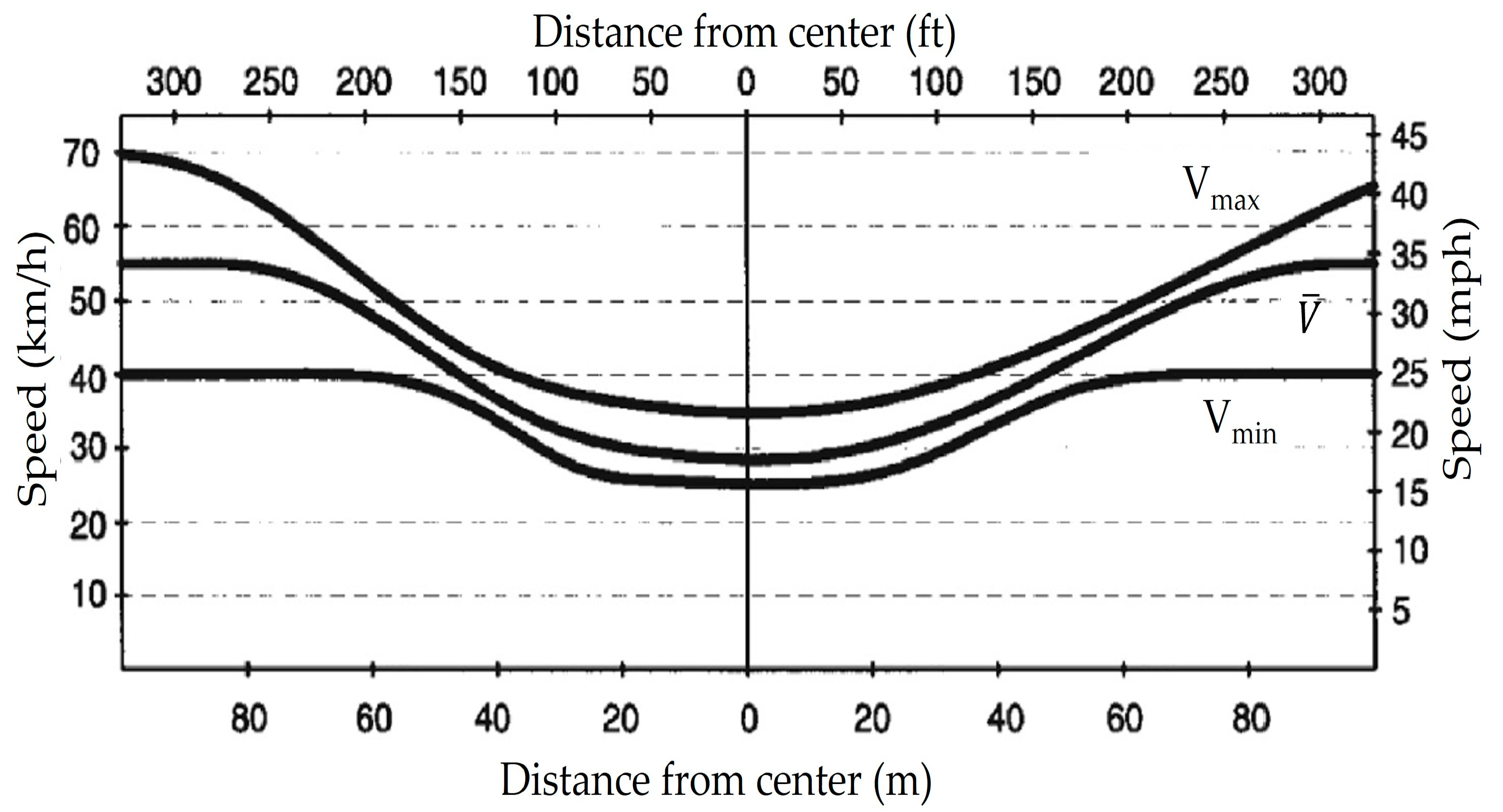


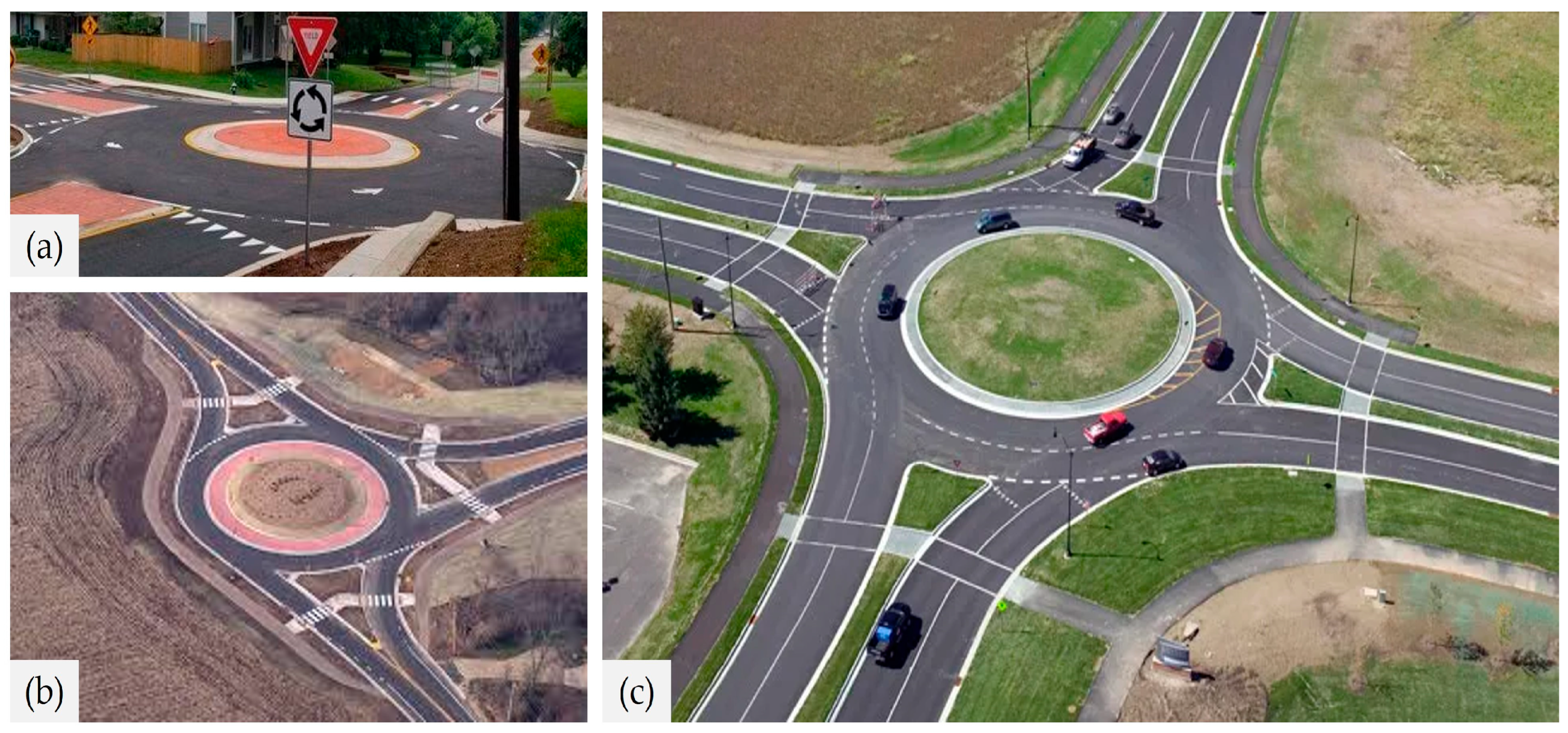
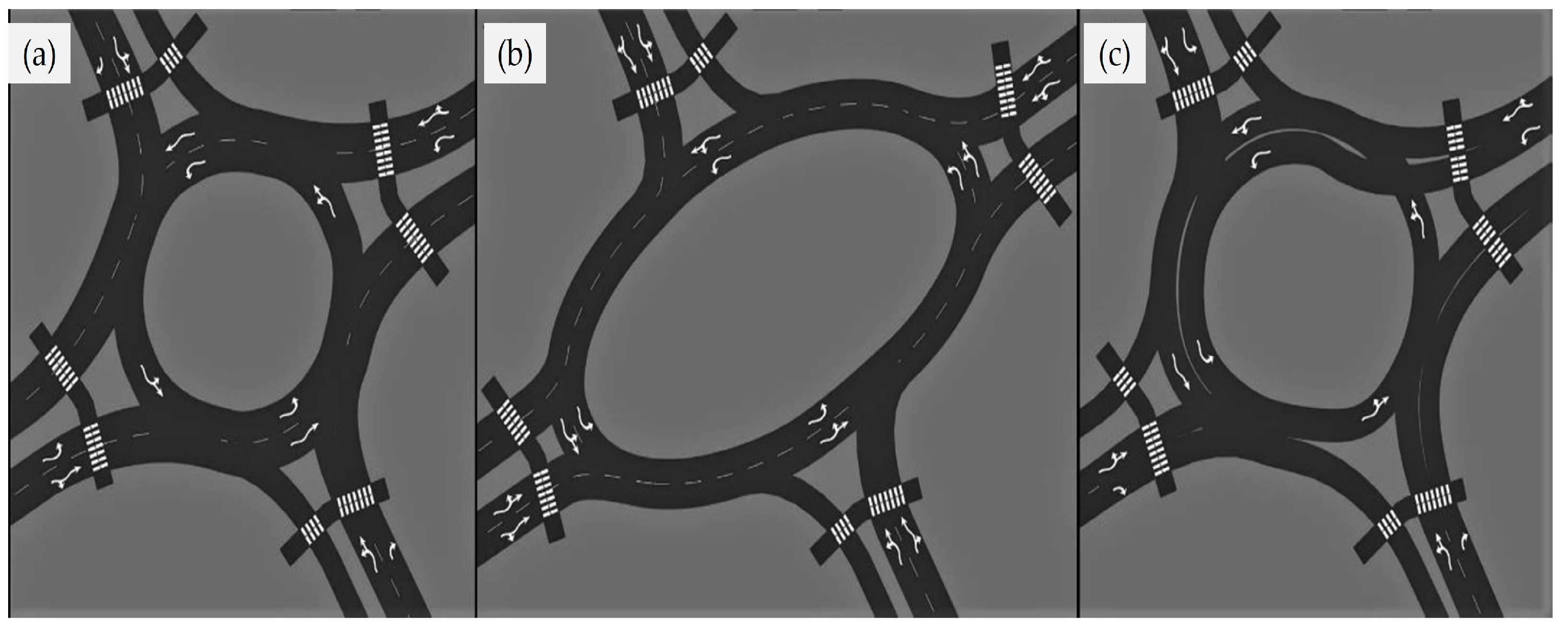
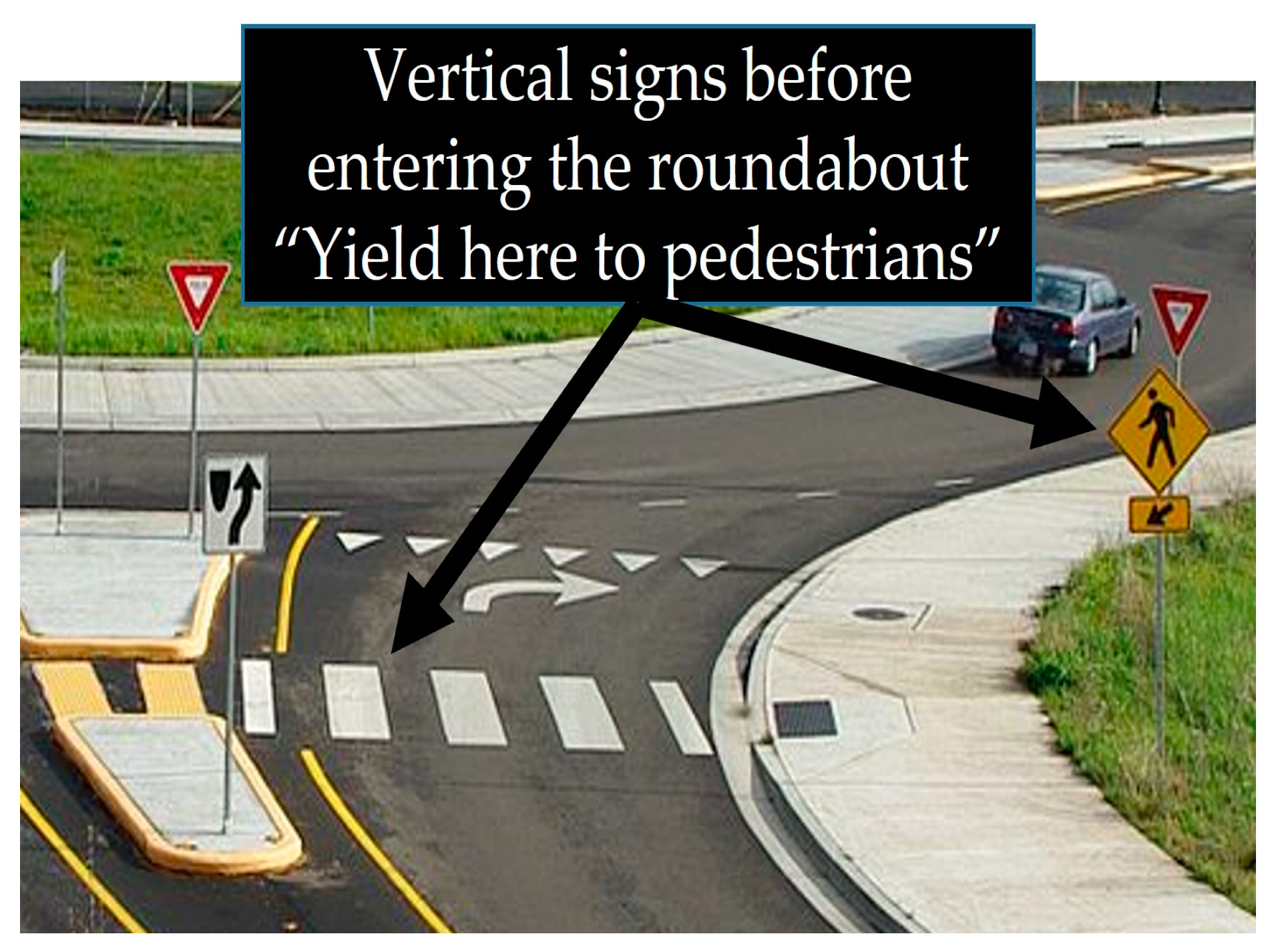
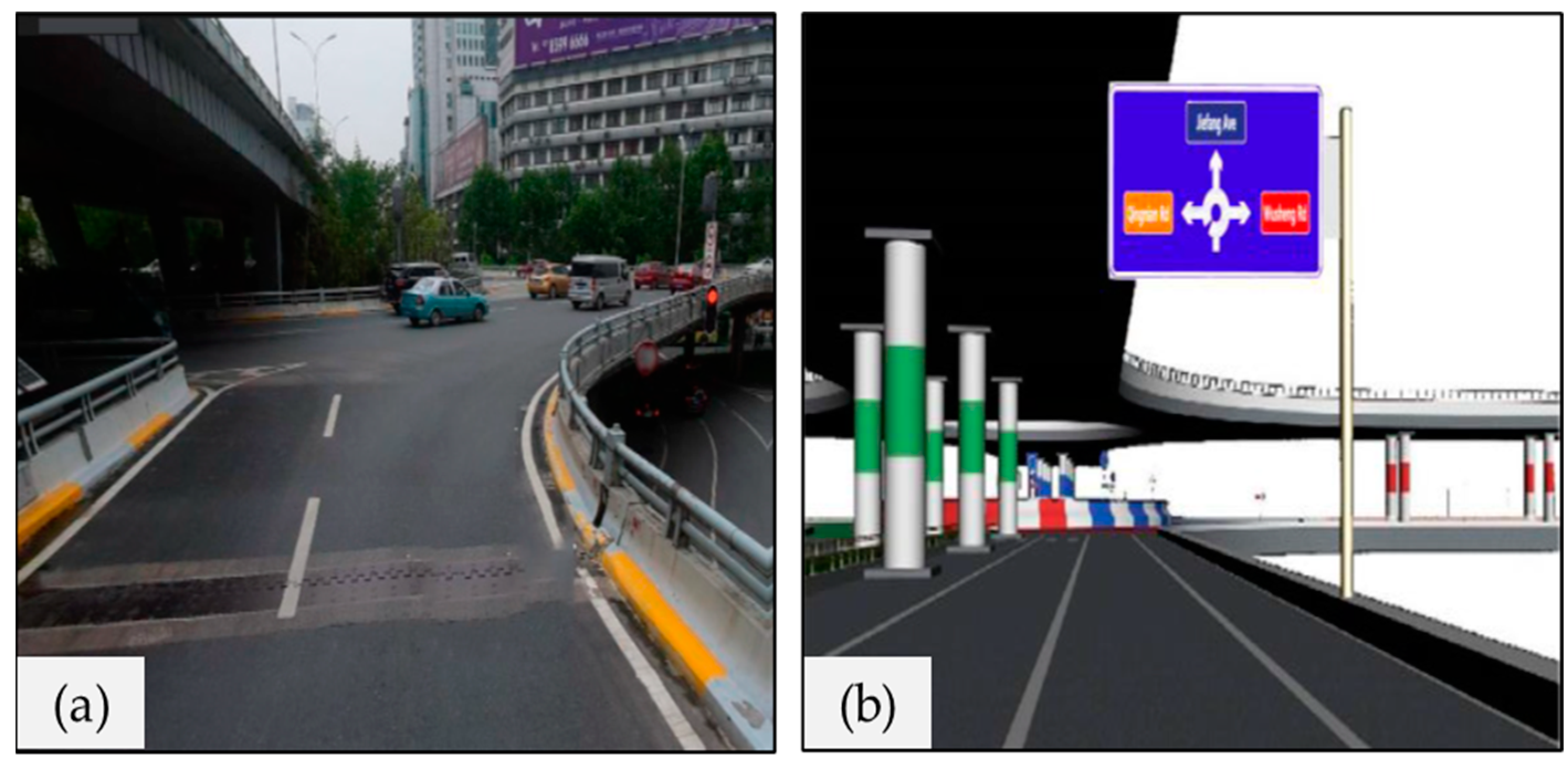

| Configuration Parameters | Mini Roundabout | Urban Single-Lane | Urban Double-Lane | Rural Single-Lane | Rural Double-Lane |
|---|---|---|---|---|---|
| Typical daily service volume (veh/day) | 10,000 | 20,000 | >100,000 | 20,000 | >80,000 |
| Typical inscribed circle diameter (m) | 13–25 | 30–40 | 45–55 | 35–40 | 55–60 |
| Recommended maximum entry design speed (km/h) | 25 | 35 | 40 | 40 | 50 |
| Maximum number of entering lanes | 1 | 1 | 2 | 1 | 2 |
| Splitter island configuration | Raised if possible, crosswalk cut if raised | Raised with crosswalk cut | Raised with crosswalk cut | Raised and extended with crosswalk cut | Raised and extended with crosswalk cut |
| Characteristic | Type of Conflict | Contributing Factor |
|---|---|---|
| Radius of entry and exit approach | Run-off-road/entering–circulating/exiting–circulating | Vehicle speed or deflection angle |
| Inscribed circle diameter | Entering–circulating/exiting–circulating/rear-end/sideswipe | Length of weaving section/interactions between circulating and entering vehicles |
| Number of legs | Rear-end/entering–circulating | Increase in conflict points |
| Number of lanes and lane width of an approach | Exiting–circulating/rear-end/sideswipe | Increase in conflict points/distance between parallel vehicles |
Disclaimer/Publisher’s Note: The statements, opinions and data contained in all publications are solely those of the individual author(s) and contributor(s) and not of MDPI and/or the editor(s). MDPI and/or the editor(s) disclaim responsibility for any injury to people or property resulting from any ideas, methods, instructions or products referred to in the content. |
© 2024 by the authors. Licensee MDPI, Basel, Switzerland. This article is an open access article distributed under the terms and conditions of the Creative Commons Attribution (CC BY) license (https://creativecommons.org/licenses/by/4.0/).
Share and Cite
Gkyrtis, K.; Kokkalis, A. An Overview of the Efficiency of Roundabouts: Design Aspects and Contribution toward Safer Vehicle Movement. Vehicles 2024, 6, 433-449. https://doi.org/10.3390/vehicles6010019
Gkyrtis K, Kokkalis A. An Overview of the Efficiency of Roundabouts: Design Aspects and Contribution toward Safer Vehicle Movement. Vehicles. 2024; 6(1):433-449. https://doi.org/10.3390/vehicles6010019
Chicago/Turabian StyleGkyrtis, Konstantinos, and Alexandros Kokkalis. 2024. "An Overview of the Efficiency of Roundabouts: Design Aspects and Contribution toward Safer Vehicle Movement" Vehicles 6, no. 1: 433-449. https://doi.org/10.3390/vehicles6010019
APA StyleGkyrtis, K., & Kokkalis, A. (2024). An Overview of the Efficiency of Roundabouts: Design Aspects and Contribution toward Safer Vehicle Movement. Vehicles, 6(1), 433-449. https://doi.org/10.3390/vehicles6010019









